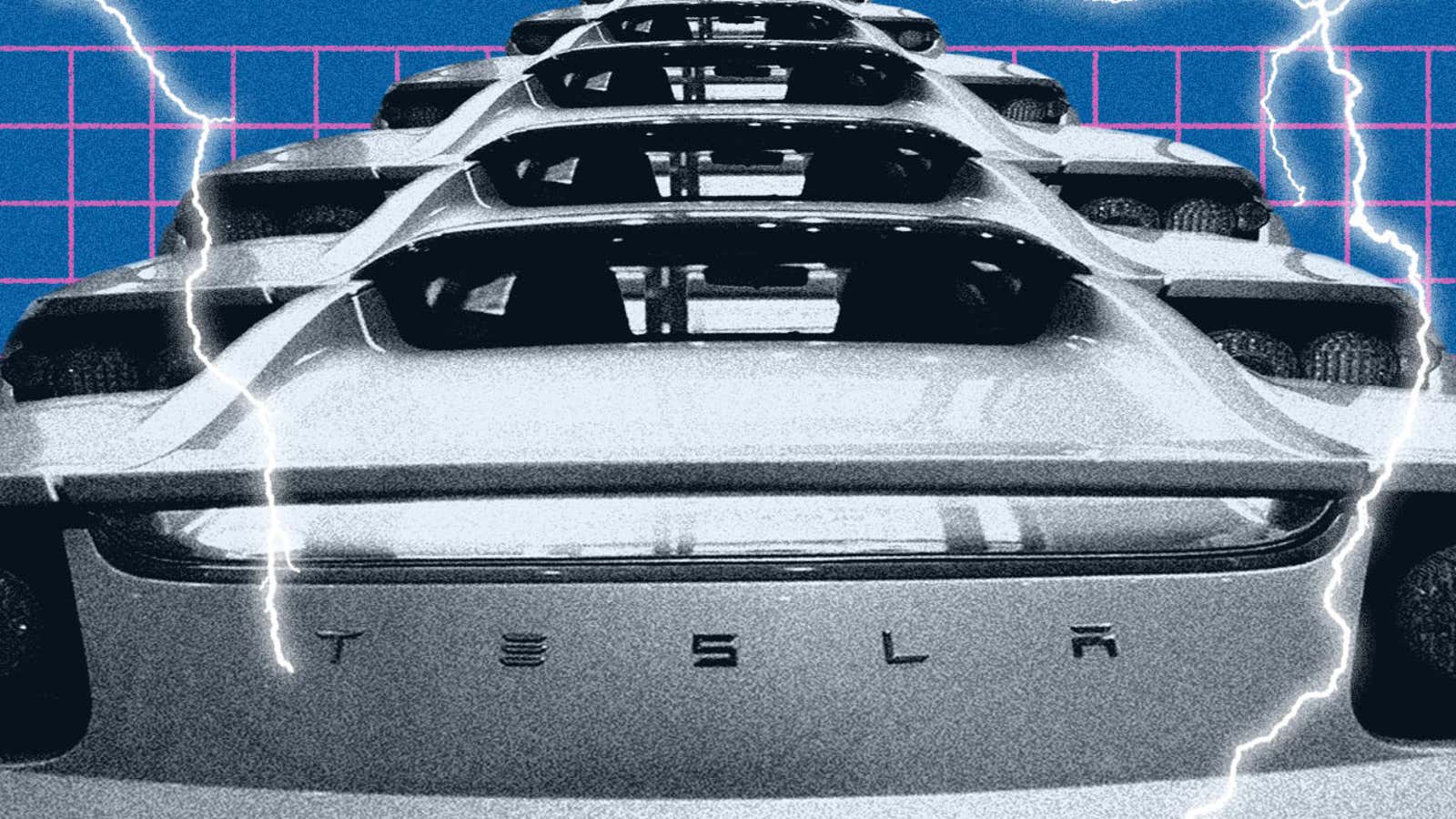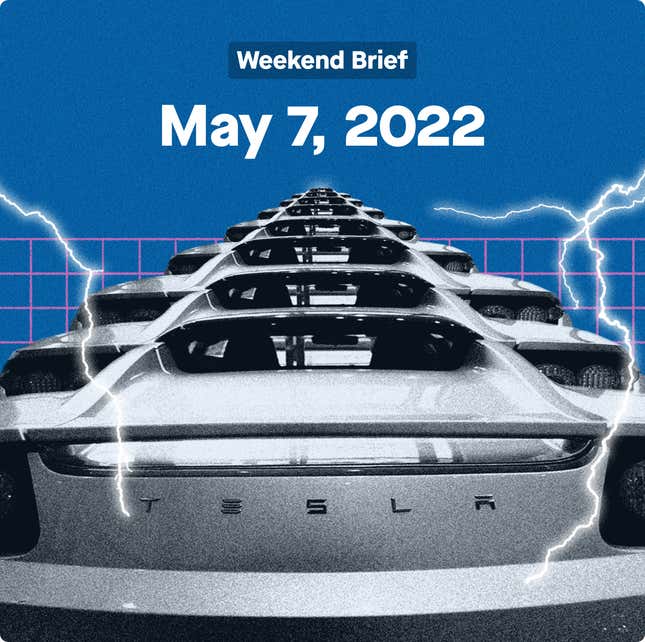
Hi Quartz members,
The first widely sold electric car in the US was the Nissan Leaf—and it was relatively affordable. In 2011, the Leaf had a sticker price of about $33,600, and accounted for over 95% of the US electric car market.
But the next year, the EV market changed: Tesla introduced its first breakthrough hit, the Model S luxury sedan, which started at $57,400. The Model S soon displaced the Leaf as the best-selling electric car, and Tesla’s luxury vehicles, including the Model 3 sedan and the Model X SUV, today dominate the market.
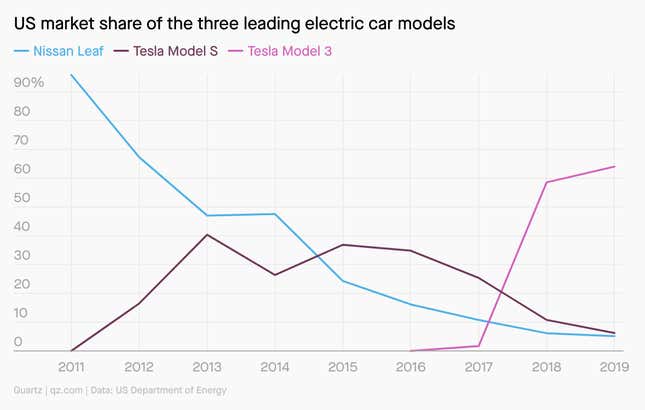
There’s no turning back now: A decade after the Leaf’s heyday, EVs are making a marked shift toward luxury. Legacy automakers such as Ford, GM, and Honda, as well as startups like Rivian, are muscling their way in with high-priced pickup trucks and SUVs. They’re also using bigger, more expensive batteries to give their EVs longer range.
More Teslas, more high-end options, and more big batteries are driving up the average price—EV prices these days track closely to the average price of a luxury vehicle.
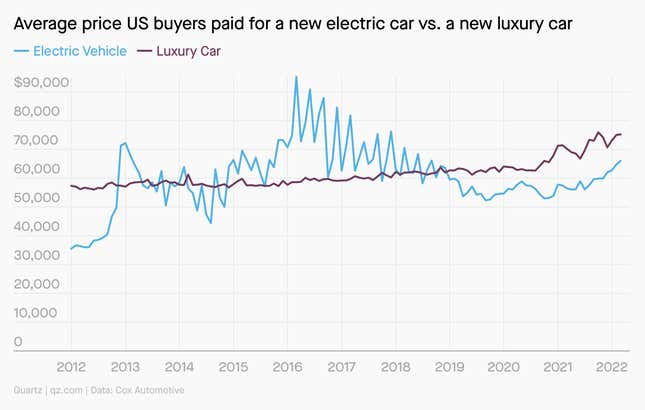
In the short run, there are enough wealthy car buyers in the US to buy as many electric cars as automakers can produce. Companies like Tesla and Rivian have months- or years-long waitlists. But high prices do deter people from switching to an EV from a gas-powered car. For the US to meet its goal of electrifying all personal vehicles, it will need automakers to roll out more affordable options.
The backstory
- EV prices are climbing. Since 2012, the average price to buy a new EV in the US is up more than 80%. Semiconductor shortages and factory shutdowns during the pandemic also drove up the price of all cars, gas-powered or electric.
- Battery prices are plunging. Since 2012, the average total cost of an EV battery has fallen more than 80%, in large part because of research investments from companies like Tesla.
- EV sales are taking off. EVs accounted for 8% of global car sales in 2021—which is still a small fraction of the overall market, but twice as high as their market share in 2020. China leads the world in sales and growth.
The EV-battery price paradox
Since batteries are the most expensive component of an electric vehicle, analysts expected that EV prices would decline alongside battery prices. It hasn’t worked out that way.
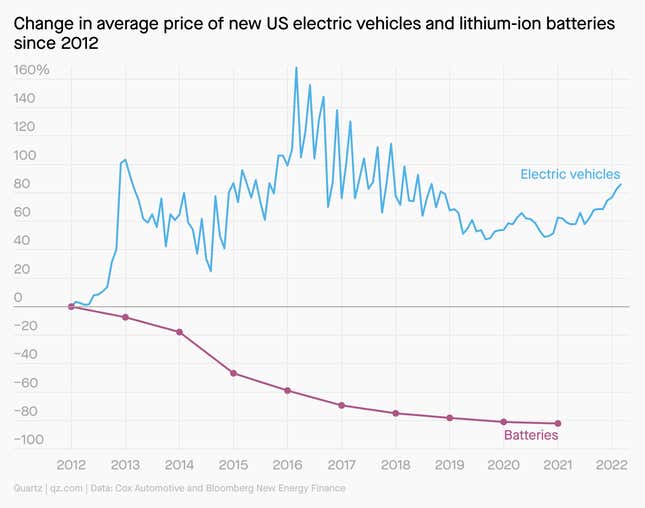
That’s because automakers are rolling out luxury electric cars before developing cheaper, mass-market versions. “It’s very common for automakers to deploy any kind of new technology on more expensive cars first, because [luxury car buyers] can bear the price,” Cox Automotive executive analyst Michelle Krebs explains. Once carmakers ramp up production volume and bring down costs, they introduce those features on more affordable models.
What to watch for next
- Honda and GM betting big on cheap EVs.The automakers have each invested billions to create their own EV lines, and in April announced a partnership to jointly develop affordable EVs that will sell for less than $30,000 by 2027.
- Metal prices driving up battery costs. Surging prices for nickel, lithium, and cobalt forced battery prices to increase slightly for the first time in a decade last year.
- The Ukraine war hitting battery supplies. Russia plays an outsized role in nickel production, and war-related disruptions in that market could slow the transition to EVs.
- The US 👀 its battery supply chain. The federal government and private businesses are investing in domestic rare earth mining and battery recycling to blunt the impact of supply chain challenges and geopolitical tensions on battery prices.
- Will battery chargers keep pace with EV sales? The construction of new charging stations is lagging behind the growth in EV sales, exacerbating drivers’ anxieties about finding a place to power up.
One 3️⃣ thing
Long the punchline of the auto world, three-wheelers are finally having a moment. The compact cars offer electric mobility at a discount price—one model sells for $18,500—and fill a niche between big, bulky electric trucks and tiny electric scooters.
Three-wheelers were the original automobile design: The first one was a steam-powered behemoth built in 1769 to transport artillery. But after it crashed into a stone wall in one of history’s first motor vehicle accidents, engineers gravitated toward more stable four-wheel designs.
Quartz questions to spark conversation
🛍️ How is Amazon passing on inflation costs?
🏭 Why is industrial policy so hot right now?
💸 What does Buffett get wrong about bitcoin?
💖 Which US companies are expanding abortion benefits?
🔭 Where will venture capitalists look next?
🏘️ Can communities be better landlords?
🥃 Is your mezcal habit killing natural habitats?
👀 How good are you at detecting bullshit?
5 great stories from elsewhere
🔎 Faking it. ZenLedger is a kind of TurboTax for crypto, and COO Dan Hannum often talked up his Wall Street credentials. But some digging by the New York Times brought Hannum’s whole biography into question. “Slowly and then all at once,” the paper writes, “lying in public has come to feel like a reasonable strategy for getting or staying ahead.”
🌆 Why skyscrapers are so short. Human history is full of buildings hitting their physical, economic, and regulatory limits. But today’s skyscrapers could be taller, and the fact that they aren’t speaks to an innovation cycle that plays out in everything from construction to cars. Works in Progress examines how we could overcome those obstacles and build even bigger.
🥔 The sad state of American chips. All over the world, people enjoy potato chip flavors like hot pot, lamb and mint, or spicy Korean ramen—but the US gets none of that. Why has to do with how chips are chosen. “In France the lowest common denominator gets you a poulet roti chip,” Eater explains. “Here, we get endless riffs on cheese and onions.”
💪 Do you even lift? Three-quarters of Americans don’t get enough exercise, in part because the fitness industry is designed for the already-fit. “You can’t just teach millions of children that exercise is painful, humiliating, or a punishment for their failures and expect them to swan into adulthood with healthy, moderate beliefs about their bodies,” The Atlantic argues in an insightful critique.
💔 Scam and the city. For decades, an Upper East Side man scammed unsuspecting girlfriends out of money to support his business ventures. “From the outside, it might seem strange that so many people could have fallen for Nelson’s falsehoods,” writes The New Yorker. “But that is the con man’s true art: finding precisely the person who is inclined to believe him.”
Thanks for reading! And don’t hesitate to reach out with comments, questions, or topics you want to know more about.
Best wishes for a high-end weekend,
—Nicolás Rivero, tech reporter
